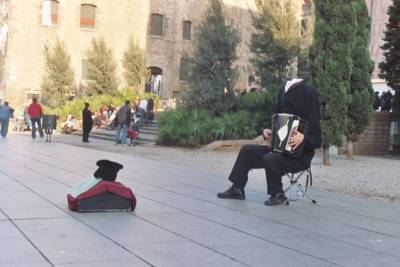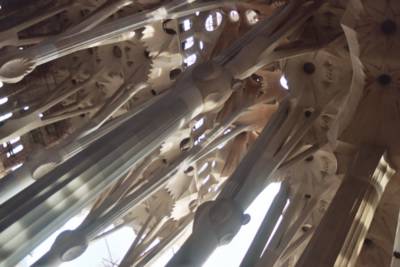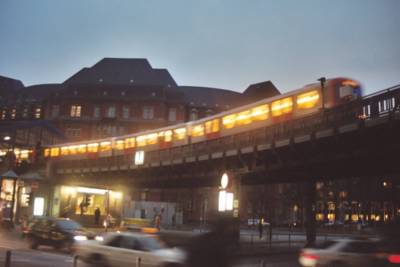The city is basically divided in thirds thanks to two rivers that run parallel north to south: the Rhone and the Saone. The easternmost third is the newest and most modern part full of modern day high rise buildings. Cross the bridge westward and the city gets more interesting as it begins to reveal its architectural nuances. This part of the city is just a sliver of land hosting old buildings with ornate facades, stuffy European hotels, charming storefronts, and overpriced restaurants. Cross yet another bridge and the historical medieval city center comes to life. In the medieval city, the buildings hold secrets of their own and the Roman theaters echo moments of an ancient past.
A friend and I ventured to find Lyon’s secrets on a chilly, yet sun-filled November morning. We took the train-lift up through darkened tunnels, to the road where the ancient Romans walked. Under my feet, a path of stones lay unevenly and in peculiar positions with overgrown grass flourishing between them. The path led to a maze of walls cut from ruined stones that have not seen a roof over them for some hundreds of years. Just beyond these ruins, up on the hillside, stood a glorious ancient theater.

Gallo-Roman Theater
I seized the stage, closed my eyes, and imagined the ancient Romans filling the seats in togas and Birkenstocks watching my performance of Homer’s Iliad. The acoustics were clear, and as I stood in silence, I listened to the winds & whispers of visitors that stood high up in the seats. I climbed the steps to become a Roman myself, and as I turned to look at the stage, I was enchanted by the city backdrop that stretched as far as the eye could see. The orange-tiled roofs glowed and the river waters glistened with absolute brilliance.
Within eyeshot the Cathedrale St.-Jean stood pompously above all other neighboring buildings on the hill. It too was an impressive structure reminiscent of many of Europe’s old cathedrals. Its architecture was cold and evoked an ethereal feeling as I looked up into the gigantic dome and the echoes resonated in my head, making me feel like a simple and diminished being. I stood amidst a rainbow of candles, each representing a prayer, perhaps a prayer for the family, or a miracle for a sick mother, or for atonement of a burdensome guilt, or maybe just a pretentious prayer by one who wanted to see the inside this cathedral. All in all, St-Jean seemed to inspire me with fresh imagination and wonder.

Prayers of the faithful at the Cathedrale St.-Jean
We said goodbye to St.-Jean as we snaked down a hillside garden full of marble statues and water fountains. Through brief openings in the trees, we caught glimpses of the cathedral for the last time. After descending a never-ending set of steps, we found ourselves on the cobblestone streets of medieval Lyon.

Neverending Steps
Here we were welcomed by the scent of fresh baked bread, almonds, and the charming restaurants that called to us like Sirens. Our hunger at that point was relentless, but knowing that the day was dwindling we resisted the temptation in order to explore the secret traboules of Lyon.
The traboules are a series of tunnels that the ancient Romans built within the ancient buildings. These shortcuts served the merchants, silk traders and vendors who wanted to protect their goods as they traveled through the city. Nowadays, many of the traboules are hidden and can only be found by pushing randomly on any given old oaken door. At first, we pushed rather tentatively on a few doors thinking that some curmudgeon of an old man might pop his head out and with a thick Pepe le Peu accent, scream “Get lost, you stupid Americans.”
Then finally, one door creaked open to reveal the mouth of a darkened traboule. We entered the musty labyrinth with careful footsteps along a narrow passage, leading up a spiral staircase, and past locked gates of what seemed like the chambers of an old dungeon. We found a long straight hall with a glimmer of light at the other end, and began to inch closer and closer when suddenly an elderly couple startled me as they turned the corner to meet my camera lens. “Pardon moi!” I said in my own pathetic version of French, and then I turned to find myself at the central courtyard of this ancient building.

Traboule
After just a brief stint of daylight in this courtyard, we re-entered the darkened tunnels into another maze-like gauntlet that led to the tail-end of the traboule at another oak door at a street along the Saone River. And so as the day began to fade, we explored more traboules, unlocking the secrets that lie within. But soon the Sirens of hunger called again, and this time we succumbed to their songs and fell at the mercy of a French bistro where we found dinner.
- Marvin A.














